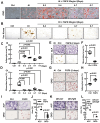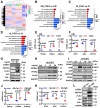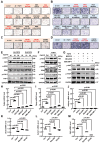Fgf9 regulates bone marrow mesenchymal stem cell fate and bone-fat balance in osteoporosis by PI3K/AKT/Hippo and MEK/ERK signaling
- PMID: 38993574
- PMCID: PMC11234224
- DOI: 10.7150/ijbs.94863
Fgf9 regulates bone marrow mesenchymal stem cell fate and bone-fat balance in osteoporosis by PI3K/AKT/Hippo and MEK/ERK signaling
Abstract
Bone-fat balance is crucial to maintain bone homeostasis. As common progenitor cells of osteoblasts and adipocytes, bone marrow mesenchymal stem cells (BMSCs) are delicately balanced for their differentiation commitment. However, the exact mechanisms governing BMSC cell fate are unclear. In this study, we discovered that fibroblast growth factor 9 (Fgf9), a cytokine expressed in the bone marrow niche, controlled bone-fat balance by influencing the cell fate of BMSCs. Histomorphology and cytodifferentiation analysis showed that Fgf9 loss-of-function mutation (S99N) notably inhibited bone marrow adipose tissue (BMAT) formation and alleviated ovariectomy-induced bone loss and BMAT accumulation in adult mice. Furthermore, in vitro and in vivo investigations demonstrated that Fgf9 altered the differentiation potential of BMSCs, shifting from osteogenesis to adipogenesis at the early stages of cell commitment. Transcriptomic and gene expression analyses demonstrated that FGF9 upregulated the expression of adipogenic genes while downregulating osteogenic gene expression at both mRNA and protein levels. Mechanistic studies revealed that FGF9, through FGFR1, promoted adipogenic gene expression via PI3K/AKT/Hippo pathways and inhibited osteogenic gene expression via MAPK/ERK pathway. This study underscores the crucial role of Fgf9 as a cytokine regulating the bone-fat balance in adult bone, suggesting that FGF9 is a potentially therapeutic target in the treatment of osteoporosis.
Keywords: Adipogenesis; Bone marrow adipose tissue; Bone-fate balance; Mesenchymal stem cells; Osteogenesis.
© The author(s).
Conflict of interest statement
Competing Interests: The authors have declared that no competing interest exists.
Figures








Similar articles
-
Fgf9 Negatively Regulates Bone Mass by Inhibiting Osteogenesis and Promoting Osteoclastogenesis Via MAPK and PI3K/AKT Signaling.J Bone Miner Res. 2021 Apr;36(4):779-791. doi: 10.1002/jbmr.4230. Epub 2021 Jan 23. J Bone Miner Res. 2021. PMID: 33316109
-
Identification of potential specific biomarkers and key signaling pathways between osteogenic and adipogenic differentiation of hBMSCs for osteoporosis therapy.J Orthop Surg Res. 2020 Sep 23;15(1):437. doi: 10.1186/s13018-020-01965-3. J Orthop Surg Res. 2020. PMID: 32967719 Free PMC article.
-
FoxO3 Regulates Mouse Bone Mesenchymal Stem Cell Fate and Bone-Fat Balance During Skeletal Aging.Stem Cells Dev. 2024 Jul;33(13-14):365-375. doi: 10.1089/scd.2024.0055. Epub 2024 May 13. Stem Cells Dev. 2024. PMID: 38661524
-
Update on the Role of Glucocorticoid Signaling in Osteoblasts and Bone Marrow Adipocytes During Aging.Curr Osteoporos Rep. 2023 Feb;21(1):32-44. doi: 10.1007/s11914-022-00772-5. Epub 2022 Dec 24. Curr Osteoporos Rep. 2023. PMID: 36564571 Free PMC article. Review.
-
NOX4-reactive oxygen species axis: critical regulators of bone health and metabolism.Front Cell Dev Biol. 2024 Aug 12;12:1432668. doi: 10.3389/fcell.2024.1432668. eCollection 2024. Front Cell Dev Biol. 2024. PMID: 39188529 Free PMC article. Review.
Cited by
-
The components and regulation of the Hippo pathway and its relationships with the progression and treatment of Non-small cell lung cancer (NSCLC).Cancer Cell Int. 2025 Aug 20;25(1):309. doi: 10.1186/s12935-025-03946-0. Cancer Cell Int. 2025. PMID: 40830878 Free PMC article. Review.
-
SUN1 inhibits osteogenesis and promotes adipogenesis of human adipose-derived stem cells by regulating α-tubulin and CD36 expression.J Cell Mol Med. 2024 Oct;28(19):e70143. doi: 10.1111/jcmm.70143. J Cell Mol Med. 2024. PMID: 39383106 Free PMC article.
-
Cordycepin Activates Autophagy to Suppress FGF9-induced TM3 Mouse Leydig Progenitor Cell Proliferation.Cancer Genomics Proteomics. 2024 Nov-Dec;21(6):630-644. doi: 10.21873/cgp.20479. Cancer Genomics Proteomics. 2024. PMID: 39467624 Free PMC article.
-
Comprehensive bioinformatics analysis reveals novel potential biomarkers associated with aging and mitochondria in osteoporosis.Sci Rep. 2025 Jan 6;15(1):934. doi: 10.1038/s41598-024-84926-8. Sci Rep. 2025. PMID: 39762477 Free PMC article.
References
-
- Sims NA, Martin TJ. Chapter 4 - The osteoblast lineage: Its actions and communication mechanisms. In: Bilezikian JP, Martin TJ, Clemens TL, Rosen CJ, editors. Principles of Bone Biology (Fourth Edition): Academic Press. 2020. p. 89-110.
MeSH terms
Substances
LinkOut - more resources
Full Text Sources
Medical
Molecular Biology Databases
Research Materials
Miscellaneous

